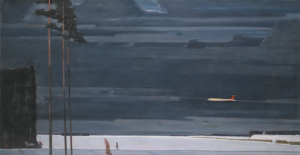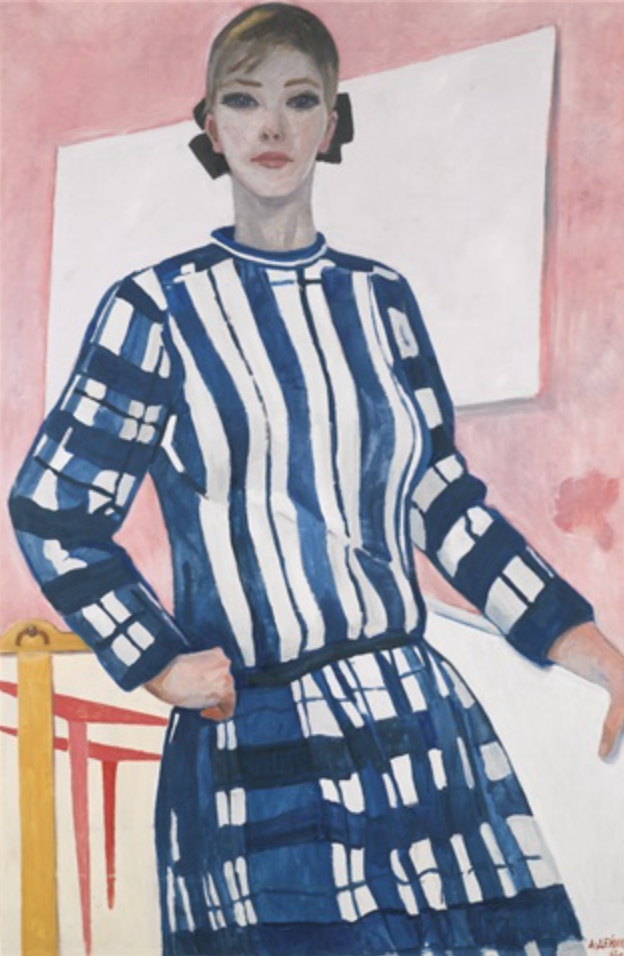Russian art exports freeze up as Culture Ministry launches criminal probe into International Confederation of Artists Unions.
May 8th, 2017 | By Ivan Lindsay | Category: Journal
Sotheby’s, London, sold Georgy Nisski’s ‘Over the Snowy Fields’ to Alexey Ananyev in June 2014 listing the owner as The Union of Artists.
Over the last 10 years various people, supposedly having access to the paintings of the former Soviet Artists Union, have approached me. This body was a sort of Trade Union for Soviet Artists (without any rights) to which artists donated artworks.
Many of the items were poorly stored, or had been rolled, and appeared to be in bad condition. Scattered through the mainly minor artworks there were masterpieces by the most famous Soviet artists such as Yuri Pimenov, Aleksandr Deinika and Sergei Gerasimov. The collection is rumored to contain 46,000 items.
The quality of the best artworks is not in doubt. Additionally their attribution is secure in that the artists themselves donated them. What was less certain was the legal status of the artworks. Originally these items had been owned by the State. In the chaotic break-up of the Soviet Union numerous assets were transferred to some kind of private ownership. So, as tempting as the artworks were, I was always uneasy as to whether they really came with clear title. In addition the prices quoted were huge.
Then, in 2013 and 2014, the artworks started being marketed by the International Confederation of Artists Union, which apparently now owned the artworks. The President of this body, Masut Fatkulin, started touring first in Moscow and then in London, with a selection of the best artworks he said he had the right to sell. A few items were sold such as a fine Deineka of a Boy standing on a balcony but mainly Fatkulin found potential buyers wary of the ownership issues.
In 2014 Sotheby’s announced the sale of 9 items from the collection including works by Pimenov, Georgy Nissky and Deinika’s well known painting of a girl known as ‘Young Designer.’ When asked, Sotheby’s said they had investigated the circumstances surrounding the items and they were confident of the legality of the sale. This gave buyers confidence and about half the items found a buyer. Deineka’s ‘Young Designer’ failed to sell because Sotheby’s put a hefty US$ 2,500,000 – 3,800,000 estimate on it. Deineka’s post-war works will of course soon be worth this, but not yet.

Aleksandr Deineka’s ‘Young Designer’ of 1966 failed to sell in London in June 2014.
The sale caused a stir in Moscow. It was one thing having the paintings in Moscow, being marketed, their legal status uncertain, but another having what was possibly Russian National Patrimony being sold off in London. Now, some three years later, the Russian Culture Ministry has launched an investigation into the sale and the items export. It appears the items were exported at very low valuations ensuring the export duty was artificially low. In addition they were exported in the name of Fatkulin as if he owned the items privately. What happened to the millions of pounds raised is not known but it appears that it didn’t end up in the right hands which presumably is why the investigation is gathering steam.
In the short term 5 Ministry officials who handled the export have been fired. Nissky’s ‘Over the Snowy Fields’, for example, which made US$2.9m at the auction, and was bought by the Moscow collector Alexei Ananyev, was exported at a value of 800,000 roubles (i.e. under US$14,000). The scandal has also triggered a purge of 125 of the art valuers who hold licenses to write export licenses.
Although the Culture Ministry supported an exhibition of the ICAU’s works in London prior to the 2014 sale, and sponsored an exhibit of some of these works in Italy, it has recently told the The Associated Press that it now had “reasonable doubts” that the artists group ever had the legal right to sell the masterpieces at Sotheby’s. The Art Newspaper Russia is reporting that the Culture Ministry is now making plans to re-nationalise the collection and it would be a magnificent asset to distribute around the Russian Museums. The artists who donated their work cannot have envisaged the collection would be sold off to private collectors, particularly as private sales where not possible in the former Soviet Union.
Alexei Ananyev, who brought the Nissky back to Moscow and exhibits it in his vast Museum, the Institute of Russian Realist Art, is of the opinion that he has clear title to his painting. When asked he said, “We think we bought it legally, the painting has an immaculate provenance. It was acquired in 1964 and has since been the property of the Confederation, which is an NGO and can dispose of it as it sees fit.”
Sotheby’s have said they are cooperating fully with the Russian authorities who are, “investigating some aspects of the activities of the ICAU.” The ICAU in turn have confirmed to the AP that the police raided their Moscow offices in January.
Exporting artworks from Russia is always difficult as the rules are constantly changing. Sometime shippers just shut down for 6 months as they await clarification on new rules or the line adopted by a new official running the office. This scandal will either continue to escalate or could just as easily disappear. In the meantime border problems have escalated and exhibitions of Russian art abroad have been derailed as no one wants to be seen contravening any law that could result in them getting caught up in the scandal.
As usual, what is really happening is cloaked in mystery but the collection will most likely be re-nationalised in some form or other. In addition the Tretyakov Gallery and the ICAU, which share space at the modern Tretyakov on Krymsky Val, are locked in a dispute, as the Tretyakov wants to expand. Although Fatkulin, who is lying low, seemed to have a clear idea of what he had when he was marketing part of the collection, he now says the group does not have a full inventory of the works they inherited from the Soviet Artists Union. Not having an inventory will presumably prove useful when the Culture Ministry start auditing the collection to see what has been sold off.
